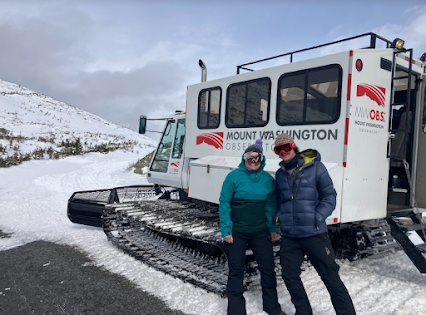Arctic Wednesdays 2023: Week 4 Post-Trip Blog
Wesley Bates
7th Grade Science
Laconia Middle School
Laconia, NH
Sitting at my desk, I sometimes find it easy to forget just just how adaptable humans are. The room is heated, there are walls to block the wind, a roof to keep any precipitation off my head and I’m comfortable in short sleeves despite February in New Hampshire. Yet only a few days ago, at the top of Mt. Washington, I froze my butt off amidst some of the world’s worst weather.
Three years ago I applied and was accepted to the Arctic Wednesdays Program, only to be rebuffed by the advent of Covid. How happy I was when I received an invitation this fall to reapply for the adventure of Arctic Wednesdays. And even more grateful to hear the news that I would have the opportunity to travel to the top with my esteemed colleague, Jess Rominger.
I am a seventh grade science teacher in Laconia, New Hampshire, where we spend a good part of our year learning the anatomy and physiology of the human body. When I was once again accepted to travel to the top of Mt. Washington I spent time considering how to connect this with my students at the middle school. And they were the ones who supplied me with the answer.
“Ugh, not again! Bates is talking about homeostasis for the millionth time!” That’s an accurate observation from a student in my class, we do talk a good deal about it. Homeostasis, for those who need the reminder, is the maintenance of a constant internal environment. To unscience that, it’s what keeps us alive. And what better place to talk about just how resilient our bodies are then on top of the Northeast’s highest point, amid some of the worst weather in the world!
The snowcat trip to the top had my excitement rising with the altitude. Jess and I peppered meteorologist Francis for info on the ride, chatting with the volunteers headed to the top, while being regaled with stories by the two summit electricians. I have hiked to the top of Mt. Washington many times but have never had the privilege to peek behind the curtain of the observatory. To travel inside to the epicenter of NH’s highest observatory and see the place that created the weather reports that I fervently pore over before every hike in the White Mountains. It did not disappoint.
Upon arrival we dropped our packs before heading to the weather deck. We had not been in the room long before the observatory's enthusiastic intern Amy convinced us that we needed a tour of the outside. It didn’t take much convincing, we were ready to experience what the day’s weather had to offer. Amy and meteorologist Karl squired us around the top of the mountain, showing us the best views, taking videos of Jess and I yelling a hello to classrooms into fierce winds, and showing us the best location to watch the sunset.
We must have been upgraded to the V.I.P. tour, Amy and Karl took us to the top of the tower where we stood atop the world. Standing there in 60 mph winds, in sub twenty degree temps, sobered my giddiness and returned me to the question I had asked my class the day before; How can humans survive and thrive in such adverse conditions? The world we live in today is tempered by the technology we surround ourselves with, yet humans have the innate ability to handle conditions far beyond what we normally experience in our lives. Sometimes it takes the most primal meetings with Mother Nature to remind us of our tenuous survival. Which could not happen without, you guessed it, HOMEOSTASIS!
The highlight of the day came when Francis Zoomed us into our classrooms back in Laconia. Students were on the edge of their seats as Francis took them through the Observatory’s historic background and day to day duties. I had come armed with student questions concerning how human homeostasis was tested in the life of a weather observer. The temperature, altitude, diet and more were all discussed, with many more questions waiting to be answered.
Returning to school the following day I saw in person the excitement of my students. The questions started before they were fully in the classroom. Some seemed surprised to see that I had survived the experience, some wanted to hear all about that crag cat Nimbus, but all were fully engaged with the conversation. For those who don’t know middle schoolers, that’s quite a pleasant surprise.
I hope that soon I will be able to return to the rarified air of Mt. Washington. I do know that the adventure I had will be something I share with students as long as I am maintaining homeostasis. I plan to incorporate this unique piece of New Hampshire into my future lessons, connecting the classroom with the outside weather and the inside anatomy and physiology that allows us to experience it!




Comments
Post a Comment